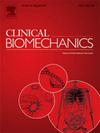健康老年人的跌倒评估:使用漫步-颤抖分解法的方法
IF 1.4
3区 医学
Q4 ENGINEERING, BIOMEDICAL
引用次数: 0
摘要
背景本研究根据综合临床和简单定量的体位测量方法,探讨了健康老年人潜在跌倒风险的有用指标。方法根据既往跌倒史,将 64 名年龄≥65 岁的社区老年人分为跌倒者和非跌倒者。在排除了两名数据缺失的参与者后,分别有 16 名和 46 名参与者被纳入跌倒者和非跌倒者组。我们进行了主要的临床测量,包括定时起立行走测试、10 米步行测试、功能性伸展测试、单腿站立测试、等长肌力测试、开合步法测试和坐立测试。在进行定量后视测量时,参与者分别在睁眼和闭眼状态下完成站立任务。在站立任务中,测量前后方向和内外侧方向压力中心的时间序列,并将其分解为漫步和颤抖成分,以分别详细评估姿势控制。结果发现,只有在前胸方向的漫游平均速度中发现了与跌倒相关的显著差异;跌倒者比非跌倒者显示出更大的数值,尤其是在闭眼站立时。漫游分量的平均速度可作为一种敏感的生物标志物,用于筛查健康老年人的潜在跌倒风险。本文章由计算机程序翻译,如有差异,请以英文原文为准。
Fall assessment in healthy older adults: Approach using rambling-trembling decomposition method
Background
This study explored useful indices of potential fall risk in healthy older adults based on comprehensive clinical and simple quantitative posturographic measurements.
Methods
A total of 64 community-dwelling older adults aged ≥65 years were classified into fallers and non-fallers based on previous fall history. After excluding two participants due to missing data, 16 and 46 participants were included in the faller and non-faller groups, respectively. We conducted major clinical measurements, including timed up and go test, 10-m walk test, functional reach test, one-leg stand test, isometric muscle strength tests, open-close stepping test, and sit-to-stand test. For quantitative posturographic measurements, participants performed standing tasks with their eyes open and closed. In the standing tasks, the time series of the center of pressure in the anteroposterior and mediolateral directions were measured and decomposed into rambling and trembling components to evaluate postural control in detail, separately. The mean velocity and root mean square of the center of pressure, rambling, and trembling were calculated and compared between fallers and non-fallers.
Findings
A significant fall-related difference was found only in the mean velocity of the rambling in the anteroposterior direction; fallers displayed greater values than non-fallers, especially while standing with their eyes closed.
Interpretation
The clinical measures failed to distinguish differences in fall risk, whereas the rambling component in the anteroposterior direction could detect substantial differences. The mean velocity of the rambling component could be useful as a sensitive screening biomarker for potential fall risks in healthy older adults.
求助全文
通过发布文献求助,成功后即可免费获取论文全文。
去求助
来源期刊

Clinical Biomechanics
医学-工程:生物医学
CiteScore
3.30
自引率
5.60%
发文量
189
审稿时长
12.3 weeks
期刊介绍:
Clinical Biomechanics is an international multidisciplinary journal of biomechanics with a focus on medical and clinical applications of new knowledge in the field.
The science of biomechanics helps explain the causes of cell, tissue, organ and body system disorders, and supports clinicians in the diagnosis, prognosis and evaluation of treatment methods and technologies. Clinical Biomechanics aims to strengthen the links between laboratory and clinic by publishing cutting-edge biomechanics research which helps to explain the causes of injury and disease, and which provides evidence contributing to improved clinical management.
A rigorous peer review system is employed and every attempt is made to process and publish top-quality papers promptly.
Clinical Biomechanics explores all facets of body system, organ, tissue and cell biomechanics, with an emphasis on medical and clinical applications of the basic science aspects. The role of basic science is therefore recognized in a medical or clinical context. The readership of the journal closely reflects its multi-disciplinary contents, being a balance of scientists, engineers and clinicians.
The contents are in the form of research papers, brief reports, review papers and correspondence, whilst special interest issues and supplements are published from time to time.
Disciplines covered include biomechanics and mechanobiology at all scales, bioengineering and use of tissue engineering and biomaterials for clinical applications, biophysics, as well as biomechanical aspects of medical robotics, ergonomics, physical and occupational therapeutics and rehabilitation.
 求助内容:
求助内容: 应助结果提醒方式:
应助结果提醒方式:


